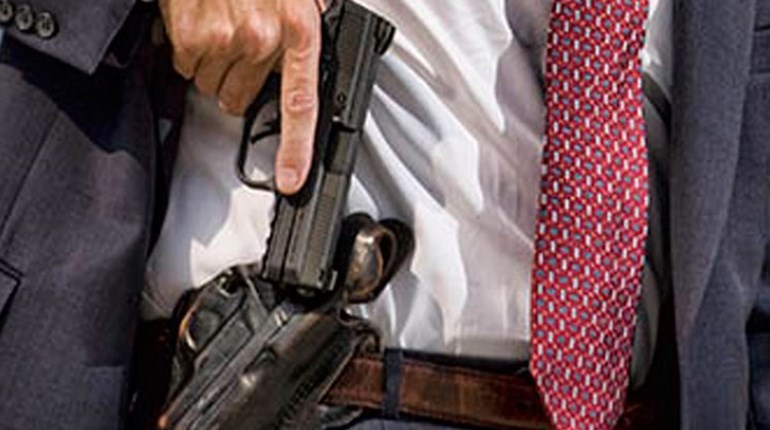
A ruling by the U.S. Court of Appeals for the Fourth Circuit finds that carrying a gun—even lawfully—is justification for police to treat you as suspect until evidence proves otherwise. This turns the normal approach to policing on its head, limiting Fourth Amendment protections normally in place for those considered innocent until proven guilty.
In fact, Ammoland reported that Judge James A. Wynn opined, “Individuals who carry firearms—lawfully or unlawfully—pose a categorical risk of danger to others and police officers, in particular.” Wynn added, “Individuals who choose to carry firearms [therefore] forego certain constitutional protections afforded to individuals who elect not to carry firearms.”
The 4th Circuit ruling was issued in United States v. Robinson, a case brought by Shaquille Montel Robinson after he believed himself unconstitutionally targeted for search and seizure—and ultimately arrested—because he was carrying a gun.
Robinson’s saga began on March 24, 2014, when an unidentified caller notified the Ranson, W.V., Police Department that they had seen “an African-American male” load a handgun, conceal it in his pocket and climb into the passenger side of a Toyota Camry “driven by a white female.”
Officer Kendall Hudson spotted the car minutes after the call was placed, and pulled the vehicle over after noting that Robinson and the driver were not wearing seat belts.
According to court documents:
After calling in the stop, Officer Hudson approached the driver’s side of the vehicle with his weapon drawn but carried below his waist and asked the driver for her license, registration and proof of insurance. He also asked the male passenger, the defendant Robinson, for his identification but quickly realized that doing so was “probably not a good idea” because “[t]his guy might have a gun[,] [and] I’m asking him to get into his pocket to get his I.D.” Instead, Officer Hudson asked Robinson to step out of the vehicle.
Captain Robbie Roberts arrived on scene as backup and opened the passenger door for Robinson to exit the vehicle. At that point, “Captain Roberts asked him if he had any weapons on him. Instead of responding verbally, Robinson ‘gave [Roberts] a weird look’ or, more specifically, an ‘oh, crap’ look.” Roberts interpreted Robinson’s look to mean, “I don’t want to lie to you, but I’m not going to tell you anything [either].”
Captain Roberts then had Robinson put his hands on top the car, frisked him, and found the handgun in his pocket. Roberts also recognized Robinson as having a previous felony conviction and arrested him for illegally possessing a gun.
This is where the whole case turns. After being charged with “illegal possession of a firearm by a felon,” Robinson “filed a motion to suppress the evidence of the firearm and ammunition seized during the frisk, arguing that the frisk violated his Fourth Amendment rights.”
Robinson and his attorneys pointed to Terry v. Ohio (1968), a Supreme Court case which held that “police officers who believe a suspect they have detained for investigation but have not arrested can conduct a limited ‘pat down’ of the suspect’s outer clothing when they have reasonable suspicion that the suspect is ‘armed and dangerous.’” They then argued that the officers had no reason to believe Robinson “dangerous,” and that the simple act of being of being armed does not necessitate a corollary of being “dangerous.”
A magistrate judge agreed with Robinson, and ruled to strike evidence of the firearm. But a District Court judge disagreed, ruling that “the high crime area in which the contact occurred, the information the officers had that Robinson was armed, and Robinson’s failure to answer when asked about weapons created a reasonable suspicion that he was armed and dangerous.”
The case then went to a three-judge panel of the 4th Circuit on appeal, and the panel agreed with the magistrate judge, thereby reversing the District Court ruling. At this point, the Obama administration’s Department of Justice asked the 4th Circuit to rehear the case en banc. The court agreed, heard the case, and ruled against Robinson.
The 4th Circuit ruled that the language of Terry—“armed and dangerous”—effectively means “armed and therefore dangerous,” thus blotting out any justifiable reason to avoid the search and seizure which led to Robinson’s arrest.
It is important to note that the point of highlighting this case is not to defend felons in possession of guns, but to defend the civil liberties of people who have interactions with police while lawfully carrying firearms. While such persons ought to be able to interact with police without being viewed as suspect, the 4th Circuit’s language of “armed and therefore dangerous” calls such a possibility into question.
AWR Hawkins is the Second Amendment columnist for Breitbart News and host of Bullets with AWR Hawkins, a Breitbart News podcast. He is also the political analyst for Armed American Radio. Follow him on Twitter @AWRHawkins, or reach him directly at awrhawkins@breitbart.com.
































